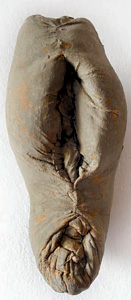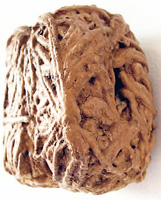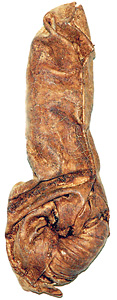Coming soon after his artistic training at the La Salle College of Art in Singapore, this exhibition marks Mahen Perera’s ‘professional debut’ in Sri Lanka. And it introduces some startling new themes, or at least startling treatment of some not so new themes. And in doing so he answers with a degree of originality the perennial question which gallery visitors ask, “why do some artists so wilfully forsake ‘realism’ and representational ‘accuracy’, and why are the results so often forbidding to the eye and revolting to good sense?
Little do they ask about the price art often pays for the accessible and pleasing effects of so-called ‘realism’. For any ‘realistic’ representation of a person or thing must necessarily rest on the illusion that the image has captured its object in some degree of stable, unchanging identity, otherwise how could we recognize the ‘reality’ we claim to see in the image?
The price paid is loss of the sense of active processes of change which things are always going through, which change takes place in time, involves the earthy processes of weather, chemistry, physics, geology and, additionally, with living organisms, external factors like food, water, and predators, while for humans they also include ‘internal’ factors such as ideas, emotions, memories, dreams, fantasies, laughter, breathing, headaches, hunger, sex, sometimes violence, and an always seething mix of psychic tensions and conflicts.
As the Proustian echo in the apt title Mahen chose for his exhibition reminds us, sometimes we sadly lose our time and other times, if fortunate, we find it. At the same time, our losing and finding are experiences that take place within bodies and minds, in actual flesh and blood, sweat and tears, mental highs and lows. Is this then a game of hide-and-seek, lost and found, forget and remember, joy and sorrow, yes and no?
Yes and no! For if we join the artist in his game and put aside our preoccupation with mirrors and how things are “supposed to look like” in art, and attend instead to the myriad ways in which our bodies and minds and the creatures and objects around us actually endure the times and processes of our daily existence, then a new, exciting, and challenging horizon of aesthetic experience opens to us— this art of material change and bodily processes is not a game (or make-believe)—it is closer in intent and effect to the experience of living itself, and among the arts, closer to dance and theatre. Its shaping dynamic is down-to-earth and paced to the ever-changing, living body and its convoluted mental processes.
As we study the objects on display, what do we see? Mostly things that have no exact physical or fabricated equivalents in our so-called ‘real’ world. Bits of canvas seemingly stained by accident of nature or perhaps inattentive artist, lumps, fragments, string, knots, scratches, scrapes, drips. Bits of canvas that look suspiciously stripped, by washing or erasure, of their former drawn and painted figures, surfaces scored with some tool or other, bleached, burned, smoked, charred, muddied, pushed, pulled, ripped, tied, stitched, glued, wrestled with, subdued, resisting, submitting, inviting in, keeping out. Suggesting genitalia, bone, rock, insect, larvae, lava (volcanic), faeces; the corroding or shaping effect of heat, sun, wind, water, earth. Things that do not know what they want to be, or are in transition from one state to another, making, unmaking, and remaking themselves; the doer, the talker, the thinker, the joker. And over it all, a master-mind at work, observing, reflecting, recording, experimenting, changing, undoing, delicately and patiently shaping or forcefully misshaping, silently conversing with the creatures which he is bringing into being, sometimes seriously at odds with them, sometimes laughing at and with them.
 |
A further consideration is that a living process does not take place in two dimensions only, as on a canvas, but in three or four. The trick of perspective makes possible the illusion of three-dimensional bodies in a containing space, all taking place, optically, in the space between the canvas surface, our retina, and brain. The actual space behind the canvas is made non-existent.
Mahen Perera cannot accept that sleight of hand (or brush). So his wetting and bleaching, stretching, pushing, and pulling of the canvas necessarily transform both its front and back sides at once. We do not always see all the resulting traces of those physical processes in the works, but it is the artist’s active and positive involvement in the process of so treating his material that becomes signifying and significant for us.
Every resulting mark on the material substance or canvas now becomes, as some critics say, a signifier of a corresponding moment in the experience of fabricating the object. It used to be said, perhaps illogically, that artworks express their makers’ feelings. Perera has put aside that cliché. Perhaps he believes, with reason, that physical objects cannot express anything.
So in place of the mystery of emotional expression he substitutes the physical marks left on the treated substance as signifiers or traces of creative and destructive action: the string wrapped so tightly about the layered, congealed canvas in object No.12 speaking to us, straight away, of the physical and mental effort he put into the tightening: we vicariously feel the tightness, for we know the effect of a belt too tightly drawn around a corpulent stomach, the fit of a tight shoe, the strap barely making it around overstuffed airline luggage, the squeeze on a crowded Colombo bus. We know the yearning to be free when we feel roped in. So we join the artist in feeling an emotion for that constricted parcel so tightly bound, and perhaps a child would want to plead with the string to please give a little slack! There is no play of mysterious illusion here, just the hardly noticed trials and joys of ordinary existence, the poetry of everyday life!
The stretched canvas hung on the walls and variously treated in the shaped objects no longer functions as a metaphorical mirror or window pane, but is now given instead a radical signifying function, as integument, skin, or other plane surface that necessarily joins, or separates, two different spaces—inner/outer, front/back, top/bottom, skin/muscle, surface-terrain/sub-terrain, recto/verso of a printed page, head/tail of a coin.
Looking again at No.12, we see and feel the physical tension of a force inside the lumped canvas trying to push itself out, almost to the point of bursting, against the pressure of the constricting string. We may be inspired to ask, at this juncture, how do we balance the demands of freedom and constraint (in ourselves, in a child, in making a work of art, in expressing our opinions, in punishing a criminal act)?
Perhaps the interplay of inner and outer forces is most forcefully and ironically suggested in the stretched canvas, No. 6.
There is no picture here, just a simple but puzzling smudge, mostly of black pigmented mud and sawdust, strewn and poured across the canvas surface, using fingers and rags, in a roughly centered, vertically aligned, oval shape with an irregular circumference. The textures variously evoke the action of fire, or the substance of earth, coal, sand, lava, perhaps sedimented here by rain, wind, or volcanic eruption. Or maybe it brings to mind the scab over a wound or festering sore. In all those cases, note the physical conjunction of a surface plane and either layerings of matter upon it or unseen events seemingly transforming it from below or behind.
The volcano effect suggests tremendous upheavals of subterranean energy—again, the internal pressure to break free and the restraining embrace of the earth’s surface—while the effect of flesh-sore or wound brings to mind the force of internal contamination or illness pushing against and puncturing skin. If one of Mahen’s main artistic purposes is to highlight the essential biological and psychological processes of living things, especially human, then works of this kind represent the necessary function of boundaries and barriers as sites where contending forces come together, whether to clash, compromise, or cause catastrophe.
Likewise, a psychological process always involves a contest between individual drives, impulses, desires, phobias, and fantasies and the immaterial ‘wall’ or barrier of social custom and law. Where paintings, poems, television ads, and songs may tell of two lovers separated by a wall, here is a visceral restaging of the pain of separation itself, or of the ecstatic embrace that follows the breaching of a wall. A small collection of seemingly simple objects and canvases this may be, but its gift of evocation and its insight into the temporalities and processes of our bodies, minds and psyches are of compelling interest. An auspicious and promising presence has been added to Sri Lankan art.
(The writer is an independent art-historian, art-critic and social theorist in Kandy) |



